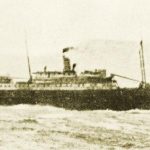Description of a Cork Waistcoat
Mr Dubourg a gentleman very fond of swimming, but subject to the cramp, was led to consider of some contrivance to secure to himself the pleasure of that exercise, without danger. For this purpose he has invented a cork waistcoat, composed of four pieces of Cork, two for the breasts, and two for the back, each pretty near in length and breadth to the quarters of a waistcoat without flaps; the whole is covered with a coarse canvas, with two holes to put the arms through; there is a space left between the two back pieces, and the same betwixt each back and breast piece, that they may fit the easier to the body. By this means the waistcoat is open only before, and may be fastened on the wearer with strings, or, if it should be thought more secure, with buckles and leather straps.
This waistcoat does not weigh above 12 ounces, and may be made up for about five or six shillings expense. It is more simple in its make than the bag, not liable to the inconvenience of being blown up, as is absolutely necessary to the use of the bag, nor, like that, subject to be torn. Mr Dubourg has tried his waistcoat in the Thames, and found that it not only supported him on the water, but that even two men were not able to sink him, though they made the utmost efforts for that purpose.
If those who use the sea occasionally and especially those who are obliged to be almost constantly there, were to have these waistcoats, it would be next to impossible, that they should be drowned. This expedient considered as a pleasurable article, to those who love swimming, is not contemptible, but further and greater uses may be derived from it. As it would be of vast service to those, who, for their health sake, bathe in the sea, and even the most timorous and delicate young lady might boldly venture, with one of these waistcoats, into a rough sea.
I need not say how useful they would be to the Navy, and how many lives they would save. And as we have now experienced, that the coasts of France are not inaccessible, surely these waistcoats might be of prodigious service to our men in embarking and disembarking; as it would be impossible, that even those who cannot swim, should be drowned before they could receive help from the boats. The expense of providing a sufficient number of them for our Navy, can be no objection to a nation so wisely and gratefully fond of a marine. Besides, the charge cannot be great; if a single one can be made for about five shillings, surely 30 or 40,000 may be made, upon an average, for much less a price
Again it is to be remembered that Cork will last for very long time; and the canvas, which would seldom want renewing, is the least chargeable material. I therefore hope to live to see them introduced on board our whole Navy; and to hear that many lives are saved by them. T.F.
From the Annual Register 1759


